Horrorstör is basically a novel about a haunted IKEA. There’s no romance in it, but it’s relevant to the interests of the Bitchery in the sense that it’s about a haunted IKEA, a concept that should strike mingled dread and delight in the soul of anyone who has ever actually been to IKEA.
In the novel, an American company decides to compete with IKEA by offering vaguely Scandinavian-style furniture in the same store model as IKEA, except for less money. This company is called Orsk, and on a very, very bad night a few of its employees try to find out what happens in the Orsk showroom after hours. Amy, our heroine, is bribed into the overnight shift by her irritating boss, Basil. He also persuades employee Ruth Anne to do it because she’s too nice to say no. Mike and Trinity are there because they want to record a ghost and be on TV. Luckily they are in a nice, safe Ikea Orsk so nothing can go wrong, right? Wrong.
Before I get into the nitty gritty, here are three things that I adored about the book instantly:
- The concept of a haunted IKEA.
- The word “Orsk”. Say it out loud: Orsk. It’s funny, right? My apologies to people who live in Orsk, Russia. I’m sure that to a Russian speaker the name is not funny, and having googled “Orsk” it looks like a lovely (and cold) place. But to my American ears the word is the perfect stand in for IKEA – a word clearly selected at random by marketing officials who didn’t think this through. Did they know that Orsk is the name of an actual town in Russia? Did they care?
- The cover. The whole design of the book is phenomenal, and I’ll talk about that in more detail, but even if the creativity had been limited to the cover I would have given this book some love. The front is pictured above – here’s the back:

When it comes to horror I’m a lightweight. I thought this book was scary, but I think a lot of innocuous things are scary. Just because this book made me have a nightmare about a haunted store doesn’t mean you will find it scary at all. The more over the top, gross, Grand Guignol moments are more horrifying than scary, because they are so far removed from our regular experience. But as someone who finds IKEA to be totally disorienting in real life, the early scenes in which Amy and Ruth Anne get lost in the showroom were incredibly spooky.
Fellow reviewer Amanda also liked the book, but she didn’t find it particularly scary: “It’s a little gross but it’s got a nice blend of horror and humor, which is usually how I prefer it.”
The tone starts off funny, and as the story progresses it turns creepy and escalates to, “Holy crap what just happened!” The tone is reflected by the layout of the book, which resembles an IKEA catalog, and which opens each chapter with a new advertisement. Initially the ads are for innocuous, even cheerful pieces of furniture, but the captions become more and more ominous and the furniture weirder and weirder.
Initially I was put off by the writing style, but then I realized that the whole book is written in IKEA language – short words, short sentences, to the point.

Even in the darkest moments, the absurdity of the situation adds some sardonic humor. It’s hard not to giggle at a line like “They nailed me inside a Liripip” or a scenario in which someone’s survival depends on disassembling cheap furniture with one of those weird Allen wrench things (Orsk calls them “magic tools” and luckily everyone who works there carries a bunch in their pockets, though usually that’s so that they can put stuff together, not take stuff apart).
The main appeal to the book is the concept, not the characters, but I loved Basil, the manager whose character development I won’t spoil, and the heroine, Amy, who starts off being pretty immature and shows her inner grit and compassion as the story develops. Ruth Anne is a great person with hidden depths.
For a book which is mainly an excuse to figure out what would happen if you were shrink wrapped to an office chair (bad, bad things, that’s what would happen) most of the characters get at least a little development and Basil and Amy get a ton. Their development is believable and deeply satisfying (but not romantic).
Spoiler about the tone of the ending:
The hot rumor is that this book is being made into a TV series. I won’t be watching it because watching scary things makes me pee my pants, but I’m having fun casting it in my head. Meanwhile, this is a fun book to read for Halloween, during a move or a remodel or any other IKEA-themed occasion, or any time you want a book with a female character who develops in a plausible and exciting way, some snarky satire about consumerism, and a lot of very weird, rather gross imagery. And if, like me, you think IKEAs are inherently creepy, then as soon as the first fake door in the book opens into a world of pain you’ll have the deep satisfaction of yelling, “I KNEW IT!”
